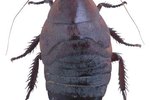
There are several animals with eyes that are larger than their brains that live on land and in the ocean. These animals with exceptionally large eyes have enhanced vision that allows them to thrive in their natural habitats.
Ostrich

The eyes of the ostrich are about the size of billiard balls -- their brains are smaller, meaning they're not very smart birds. Although ostriches aren't brilliant, they are capable of running at tremendous speeds of up to 40 miles per hour to escape their natural predators. They can cover 10 to 16 feet in a single step. In addition to having eyes that are bigger than their brains, ostriches also lay the biggest eggs in the world.
Giant and Colossal Squids
The colossal and giant squids not only have eyes bigger than their brains, they also have the largest eyes in the animal kingdom. They can be as large as 10 inches in diameter, allowing the squids to see in areas with little to no light. Giant squids live up to their name, being on average 33 feet in length -- almost as long as a standard school bus.
Tarsier
The tarsier has enormous eyes -- each pupil is 1.5 cm around, while each tarsier is only 12 cm long. Each eye is about the same size as its brain. These small primates are also unique because they have two very large ears that move independently from one another, allowing them to hear better to locate their prey. Like other creatures with features that can appear disproportionately large, their eyes that allow them a special ability to see and hunt at night when other animals are not able to do so.
Benefits of Large Eyes
Animals with eyes that are exceptionally large can see in situations with low light, or for longer distances, than smaller eyes would normally allow. The giant squid, colossal squid and tarsier all use their large eyes to better hunt their prey at night, or in the deep depths of the ocean where the giant and colossal squids live. The large eyes of the ostriches allow them to see for long distances in the desert terrain so they can stay one step ahead of predators.
References
Photo Credits
-
Anup Shah/Digital Vision/Getty Images
Writer Bio
Based in Lexington, Ky., Christina Root has worked as a blogger, writer and freelance consultant since 2009. As a mother, animal lover, natural alternative medicine enthusiast and a student of all things, she loves learning and sharing with others.




